Art World
Taking the Plunge: 5 Famous Artists on Risking Their Dignity—by Trying Performance Art
Performa has offered artists, including Julie Mehretu and Rashid Johnson, the chance to experiment with live art.
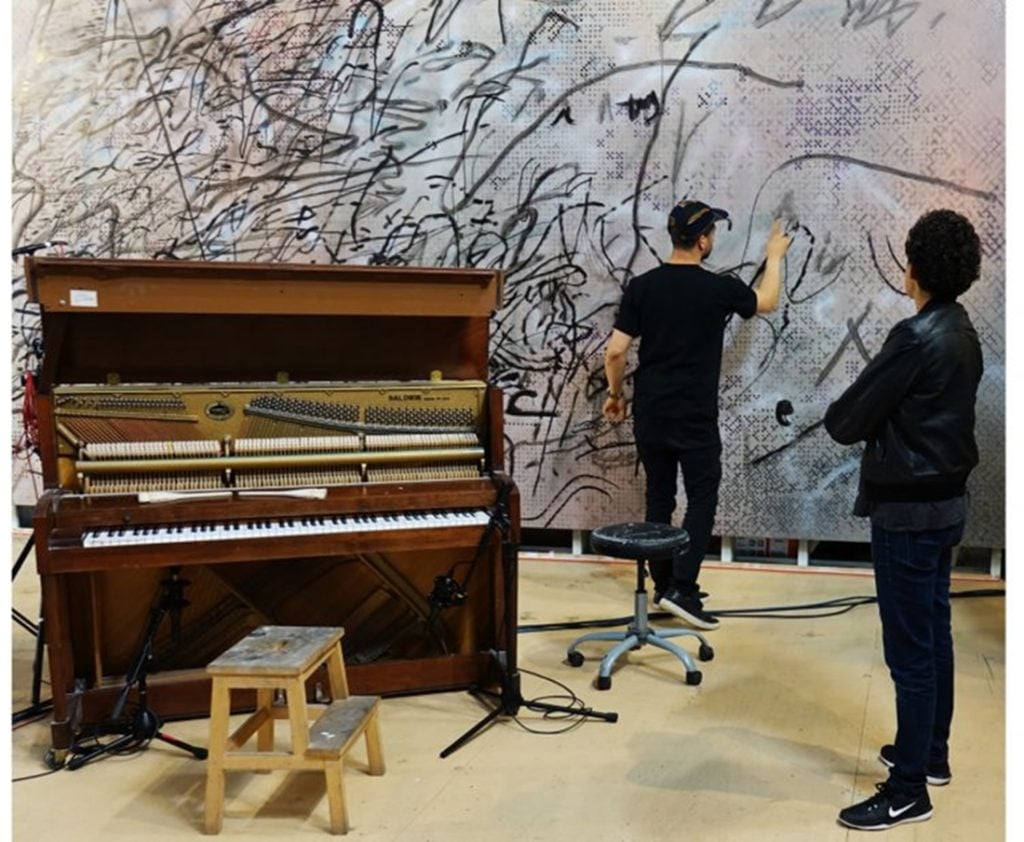
Performa has offered artists, including Julie Mehretu and Rashid Johnson, the chance to experiment with live art.

Hilarie Sheets

What is it like for an artist to transform her work into a live performance for the first time? “Terrifying,” says the photographer and filmmaker Shirin Neshat.
Luckily, fear hasn’t prevented numerous artists—including Neshat, Julie Mehretu, and Rashid Johnson—from taking the plunge. Since 2004, Performa, the performance art biennial in New York, has asked visual artists working in a range of media to adapt their ideas to live art, sometimes for the first time. The results can permanently change the course of their work.
The art historian RoseLee Goldberg was originally inspired to launch Performa after inviting Neshat to create her debut performance, Logic of the Birds, in 2001 at the Kitchen in New York. She asked the Iranian artist to imagine her characters walking out of her videos and onto the stage. Since then, Neshat has staged an operatic courtroom scene for Performa in 2011 and directed a full-blown production of Verdi’s opera Aida at the Salzburg Festival this past summer. Goldberg, meanwhile, has become an expert in convincing artists to try their hand at performance.
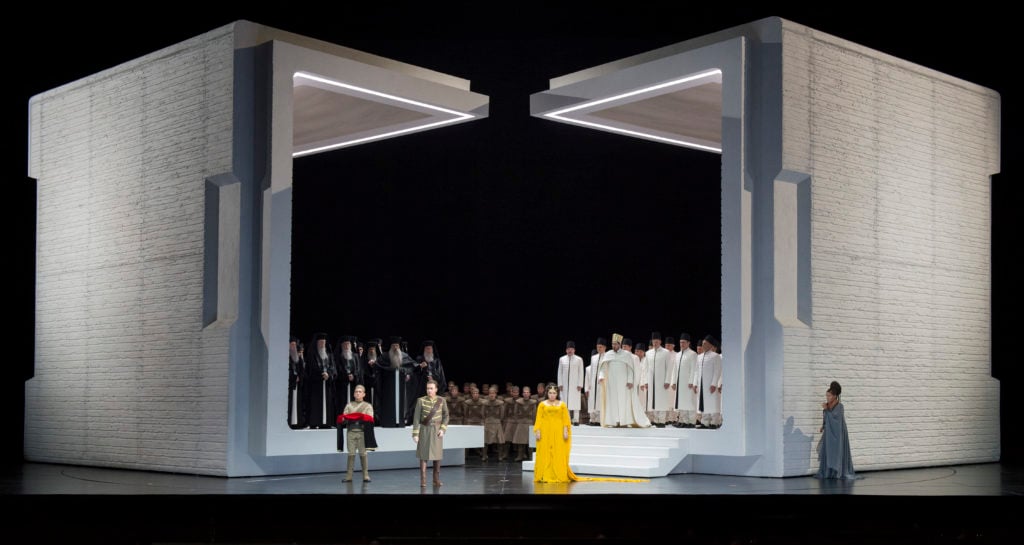
Shirin Neshat, Aida, (2017). Photo: ©Salzburger Festspiele / Monika Rittershaus
For the seventh edition of Performa, which takes place across the city from November 1 to 19, the artists Julie Mehretu, Teju Cole, Barbara Kruger, and Yto Barrada have all taken the leap outside the comfort zone of their established media and developed their first ever live works of art.
Artists who have never attempted performance before usually look at Goldberg and her curator Adrienne Edwards with dazed eyes when initially approached. “What’s so fascinating is how they come back and say ‘yes,’” says Goldberg, who has previously commissioned first-time performances by artists including Omer Fast and Adam Pendleton. “We’ve had so many conversations where these artists say what it did for them and how it’s changed the way they thought about making a sculpture or wall piece.”
Here, five artists recount their nerve-wracking, transformative experiences working in the medium for the first time.
For Johnson, who staged a reinterpretation of the 1964 political play “Dutchman” in the Russian and Turkish baths for Performa in 2013, the process opened up “a narrative quality that hadn’t been so clearly present in my work prior,” he tells artnet News. “Thinking about structure in a different way has really helped inform both what I do in my two- and three-dimensional work and in what I’m thinking about going forward.”
For an exhibition at Hauser & Wirth last year, Johnson invited the jazz musician Antoine Baldwin to play original compositions on an upright piano embedded inside his largest architectural scaffolding piece to date. Now, Johnson is in the process of making his first full-scale film based on Richard Wright’s novel Native Son.
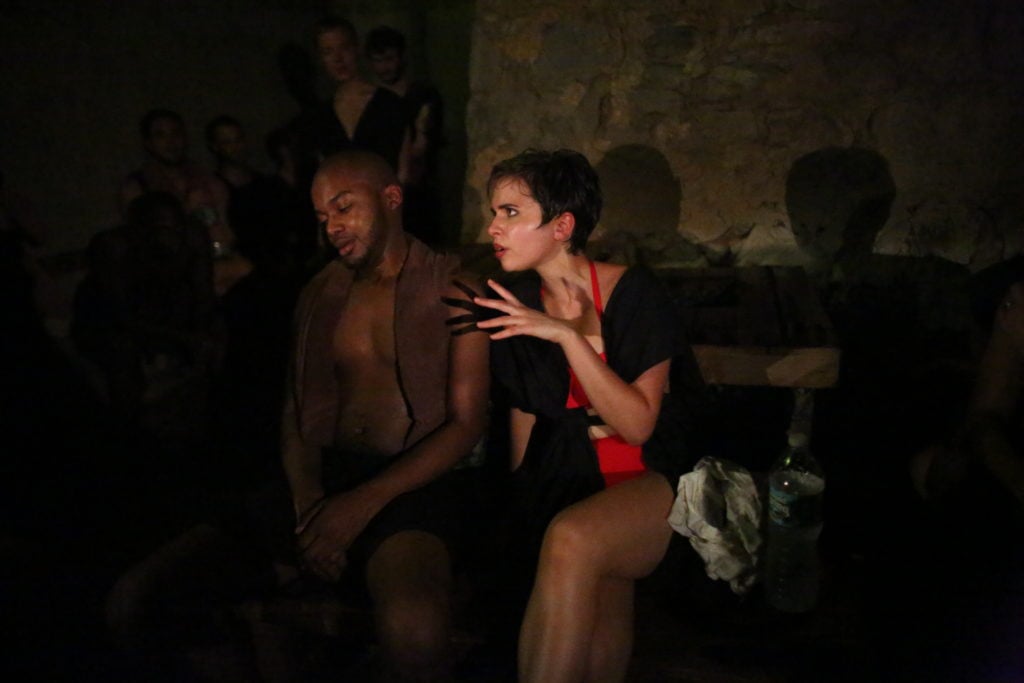
Rashid Johnson’s Dutchman (2013), a Performa commission. Photo © Paula Court.
These projects would not have been possible without his experience with Performa, he says: “The directorial nature of what I did with Performa led me to believe I can function in that same capacity—even in a different medium.”
Mehretu had long been interested in the connection between painting and sound, but had no idea how performance could transpire in her own painting. Nevertheless, she took Goldberg up on an open invitation last year after a comment from a friend, the jazz composer Jason Moran, set wheels turning in her mind.
He had told Mehretu that the abstract marks in her paintings read like musical scores. At the time, she was just beginning work on two monumental paintings for the lobby of SFMOMA and invited Moran to bring some of his instruments over to the decommissioned Harlem church she was using as a studio.
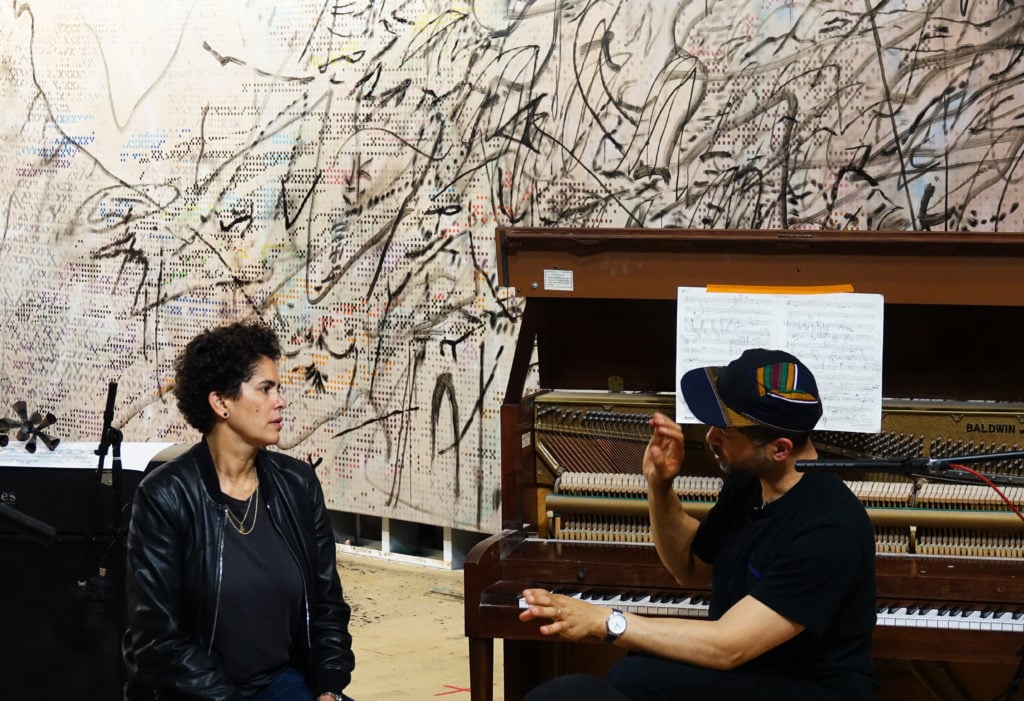
Julie Mehretu and Jason Moran collaborate on their project (2017). Courtesy of Damien Young.
“The idea was to work side by side,” Mehretu says. “Jason’s more used to that because he works with other musicians all the time, but for me it felt really naked and weird at the beginning.”
In a half-dozen sessions over the course of several months, Moran would compose responsively to the turbulent gestural mark-making evolving across Mehretu’s canvases. The painter found his music would at times “summon” her to her work and describes the “uncanny experience of hearing my drawing.” In the wake of the presidential election, Mehretu says, “We were both trying to invent and work with abstract languages in the midst of a political miasma.”
On November 16, Moran will perform his final fast-paced yet sorrowful composition on piano, accompanied by musicians on drums and cornet, in the former church against a video backdrop of the paintings (now on view at SFMOMA). Mehretu says she is interested in how sound can “slow down your experience of looking” and is excited to explore more possibilities for how performance and painting can interact.
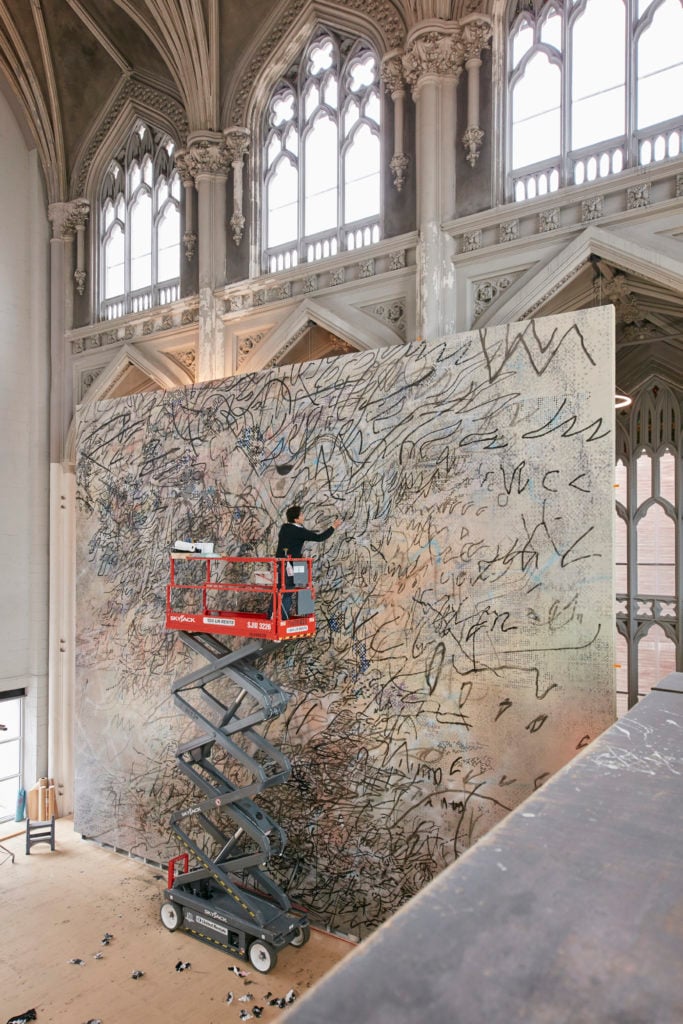
Julie Mehretu at work. Courtesy the artist and Marian Goodman Gallery © Julie Mehretu; photo Tom Power Imaging, Inc.
“There’s a fluidity and freedom that I witnessed in the way Jason made this score,” she says. “Improvisation is something I’m trying to push in the paintings.”
Performa’s Edwards initially approached Cole, who is known primarily as a novelist and photographer, about a commission because she was struck by his work’s distinctive voice and approach. “Part of his process of photographing is just him walking the streets,” Edwards says. She asked the Nigerian-American artist to think about how viewers might enter that experience with him.
The resulting project, begun after Cole started having dreams related to the election last November, is an immersive mosaic experience of this past year. Traveling all over the country, the artist made images about darkness and opacity, including shooting the eclipse. In Black Paper, to be performed November 2–4 at BKLYN Studio at City Point, he will project shifting photographs and videos on large scrims, accompanied by field recordings and text that he will perform live.
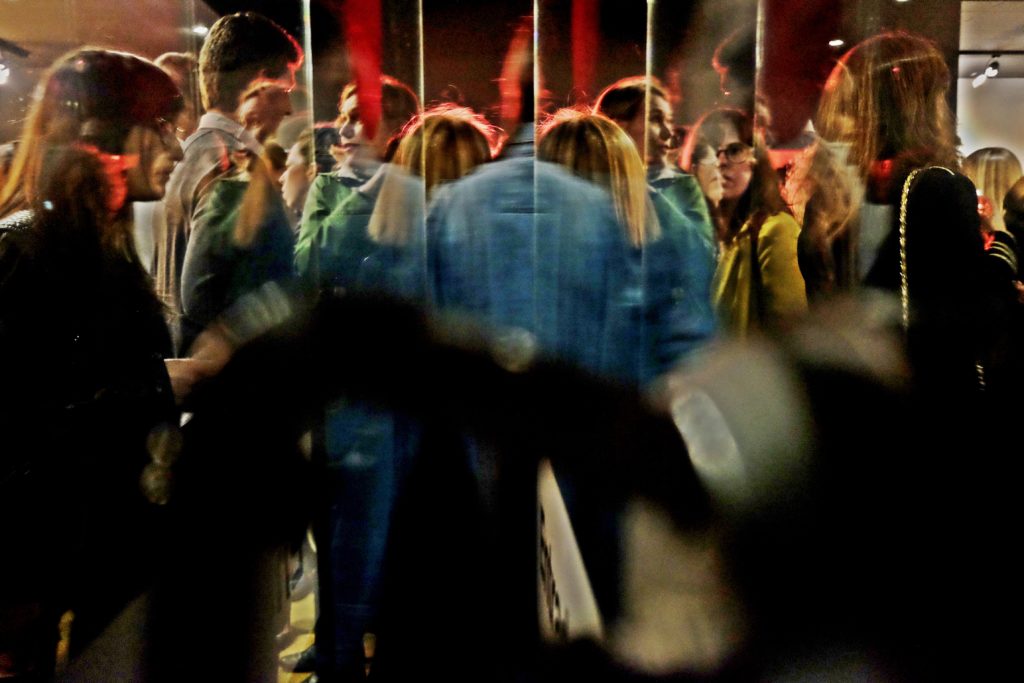
Detail of Teju Cole’s “Black Paper” (2017). Courtesy of Performa.
Cole was struck by how much more rapidly he could respond to events through performance than through writing a novel. The live medium has also allowed him to present his work with more subjectivity than is possible on the written page.
“Being in front of the public, as a black man who looks a certain way and to whom society responds in a certain way, I think this is quite relevant to the political dimension,” Cole says. “I feel like that is here to stay in my work.”
Barrada—who has worked with photography, filmmaking, sculpture, and textiles—is bringing elements of all those media to her film-based performance at the Connelly Theater from November 17–19. The artist will tell the story of a State Department-sponsored US tour for “young African leaders” that her mother attended in 1966, when she was a Moroccan student.
“She was a working-class girl, a feminist African socialist, coming to terms with the Cold War issues in America but also class and race issues,” says Barrada, who is using Montessori toys as characters to help tell the story in a film that will be overlaid by live voice-over.
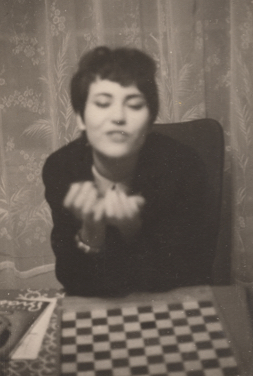
Yto Barrada,Indentification for Beginners (2017). Courtesy of the artist.
She has spent two years working closely with the Performa team to organize her extensive archival research. “Any crazy idea you say out loud, the next day it’s something they took seriously and you have to follow through and make sense of it,” says Barrada, who has found the process utterly daunting.
Yet that hasn’t stopped the artist from plowing headlong into another performance. She is choreographing the reading of a poem about reconstruction and invention after the 1960 earthquake in Morocco that will be staged at the Barbican in London in February. “I’m not escaping from that fear,” she says of her experience with Performa. “I’m jumping in even more.”
As a visual artist making a performance, “the challenge is creating a piece that maintains the enigma of art but yet has a beginning, middle, and end that is comprehensible, and people leave feeling like they got something in an hour,” Neshat says.
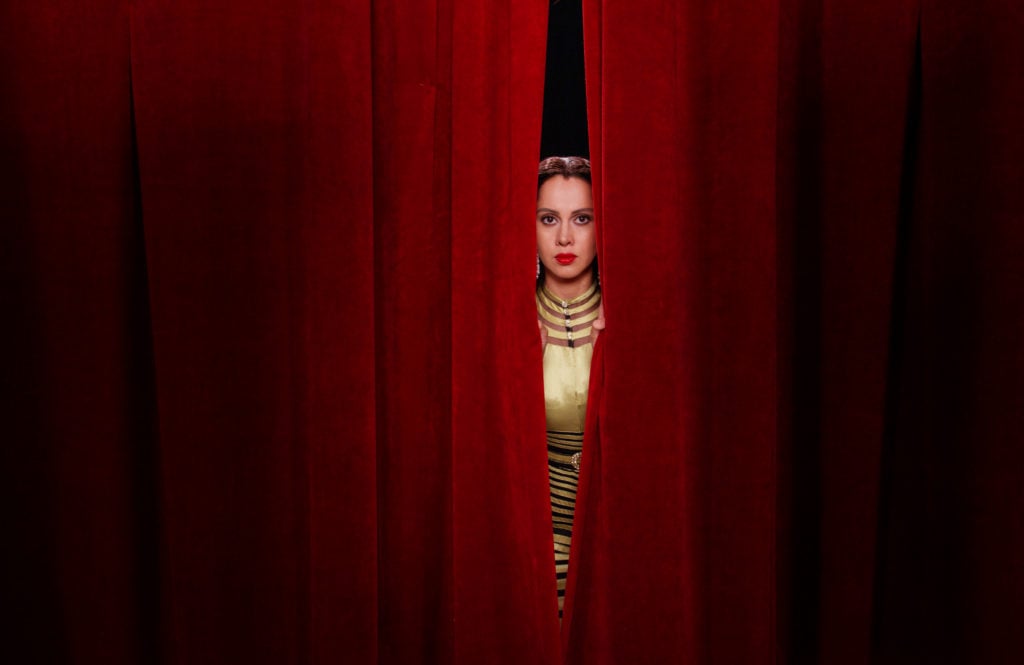
Still from Shirin Neshat’s “Looking for Oum Kulthum.”
The process gave her a better understanding of narrative cohesion, which in turn helped inform her new film, Looking for Oum Kulthum. Six years in the making, the film is a complex layering of dreams, imagination, and the stories of two women artists from the Middle East—Kulthum, the iconic Egyptian singer, and Neshat herself.
Still, Neshat says she prefers the control of the editing room to the unknown variables of live events. “It’s not a natural thing for me and the truth is I’m not sure if I’m really good at it,” she says of performance. But she hasn’t ruled out another live art endeavor. “It’s a risk, an experiment. What I love about Performa is that RoseLee is really asking artists to open their minds.”